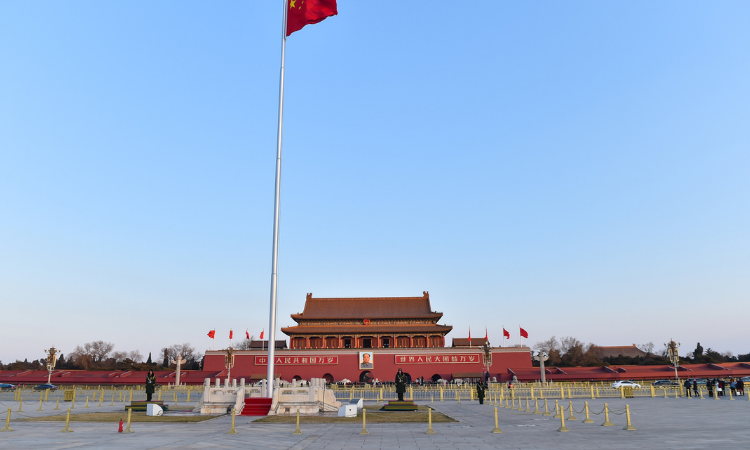Just hours ahead of the world's climate leaders gathering in Glasgow for the Conference of the Parties to the UN Framework Convention on Climate Change (COP26), China has released the new national climate commitments under the Paris Agreement, wherein it pledged to peak emissions before 2030, rather around 2030, and also to reach carbon neutrality before 2060.
Expressing no big surprise, rather disappointing, climate negotiators told IANS the new plan only epitomizes the lack of determination to step up climate action by an emitter that is responsible for 24 per cent of global emissions.
While most of the major economies have submitted an updated climate plans ahead of the key climate talks in Glasgow, India, responsible for seven per cent of global emissions, is yet to announce.
Also Read | Imran Khan calls NSC meet as TLP protests enter 7th day
In the plan, China, whose President Xi is expected to give COP26 a miss, announced to increase the share of non-fossil fuels in primary energy consumption to around 25 per cent by 2030, increase the forest stock volume by 6 billion cubic metres from the 2005 level by 2030 and bring total installed capacity of wind and solar power to over 1,200 GW by 2030, a major initiative.
Its enhanced nationally determined contributions (NDCs) comprise lower carbon intensity by over 65 per cent from the 2005 level by 2030, up from 2016 commitments of 60 to 65 per cent by 2030.
The plan follows earlier commitments by China this year to strictly control domestic coal-fired power generation and stop building coal-fired power plants abroad.
Responding to the China's plan, Greenpeace China Policy Advisor Li Shuo said: "China's decision casts a shadow on the global climate effort. In light of the domestic economic uncertainties, the country appears hesitant to embrace stronger near term targets, and missed an opportunity to demonstrate ambition.
"The planet can't afford this being the last word. Beijing needs to come up with stronger implementation plans to ensure an emission peak before 2025.
"Six years after the Paris Agreement, China's choice epitomizes the lack of determination to step up climate action among some of the major economies. It also reflects Beijing's mistrust of the United States ability to fulfill its carbon reduction and climate finance targets. There's real fear that Washington's empty words will intensify an already unfair global climate order."
Bernice Lee, Chatham House, an independent policy institute based in London, added that "we can't sugarcoat it: Beijing's new climate plan is disappointing and well off where the world's biggest emitter needs to be".
The new and updated climate commitments by nations fall far short of what is needed to meet the goals of the Paris Agreement, leaving the world on track for a global temperature rise of at least 2.7 degrees Celsius this century, warned the UN Emissions Gap report launched this week.
It finds that countries' updated NDCs. and other commitments made for 2030 but not yet submitted in an updated NDC. only take an additional 7.5 per cent off predicted annual greenhouse gas emissions in 2030, compared to the previous round of commitments.
Another report by the UN Development Programme (UNDP) says vulnerable countries are stepping up amidst a slow response from some of the biggest emitters on the climate crisis.
It reveals that while 93 per cent of Least Developed Countries (LDCs) and Small Island Developing States (SIDS) had submitted enhanced national climate pledges, or plan to do so, the G20 has been dragging its feet on adhering to the core principles of the Paris Agreement to "ratchet up" their climate ambition.
However, the China's new plan follows earlier commitments by it this year to strictly control domestic coal-fired power generation and stop building coal-fired power plants abroad.
On China's climate plan, World Resources Institute Vice President (Climate and Economics) Helen Mountford told IANS: "China's new climate commitment is a modest improvement over the country's previous plan under the Paris Agreement. For China to get on a pathway to reach its 2060 carbon neutrality goal it is critical for the country to further strengthen its new near-term targets and put in place measures to reach them.
"Our analysis shows that China can step up its efforts to reducing emission while also enjoying economic growth and a more sustainable environment."
According to Mountford, it was very encouraging that China recently pledged to stop building coal plants abroad, but the country also needs to take more actions domestically to rein in greenhouse gas emissions this decade.
"This includes rapidly shifting its energy mix from coal to wind and solar, starting to shrink its carbon footprint by 2027 or sooner, and peaking its non-CO2 emissions which have the same warming impact as Russia's total greenhouse emissions."
"China has stated in the updated NDC that it will stringently curb coal-powered projects, set strict limits on the increase in coal consumption during 2021-2025 and to phase it down during 2026-2030.
"And China emphasized again that it will effectively control non-CO2 GHG emissions. By following through on its a1+N' policy framework, China can implement a slate of domestic measures to mainstream China's climate goals across different industries and sectors."
New analysis by World Resources Institute and Climate Analytics shows that China has the potential to fill 25 per cent of the global gap between countries' current climate commitments and the emission reductions necessary to keep the Paris Agreement's 1.5 degrees Celsius temperature limit within reach.
"If the world is going to have any chance of coming to grips with the climate crisis, China, as well as all other major emitters, needs to graduate from taking small steps to giant leaps toward a cleaner and safer future," Mountford added.
In total, 178 countries representing 79.3 per cent of global GHG emissions, plan to submit enhanced NDCs before the COP26, up from just 75 countries in 2019. Of this group, 160 countries have strengthened their mitigation targets.
Now all eyes are on India's enhanced climate commitments to be announced by Prime Minister Narendra Modi at the Glasgow summit.


















